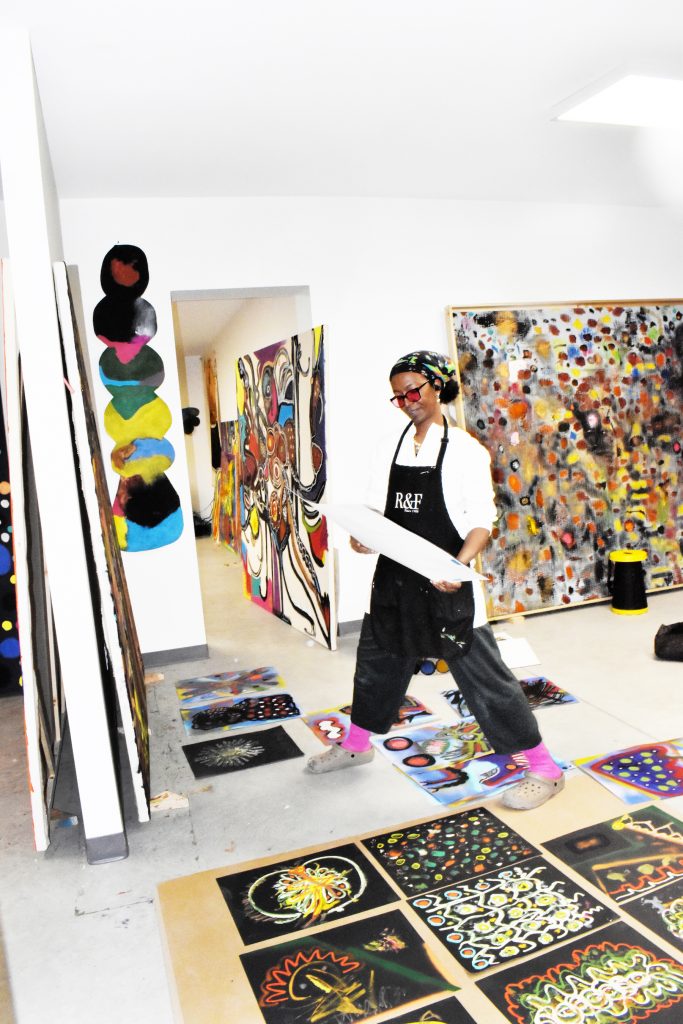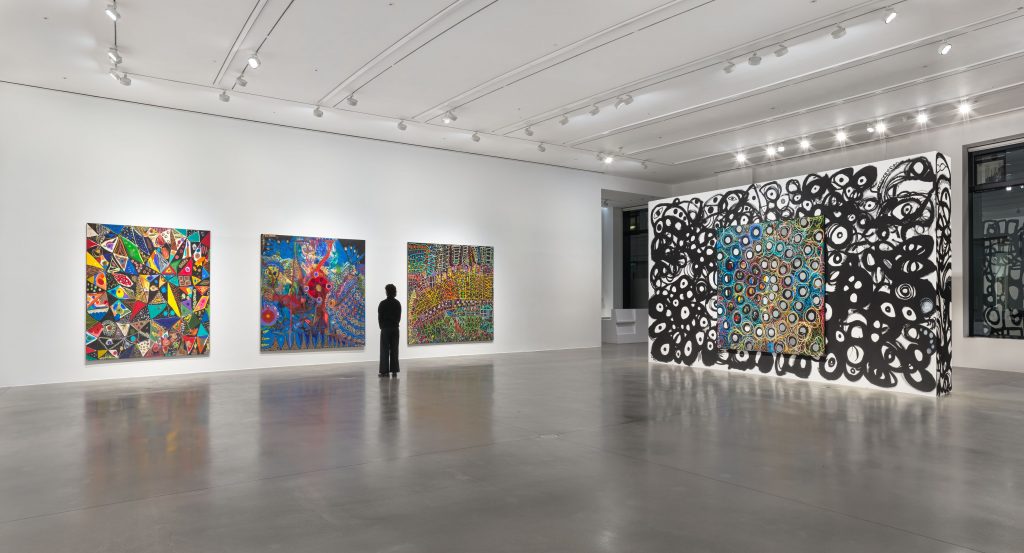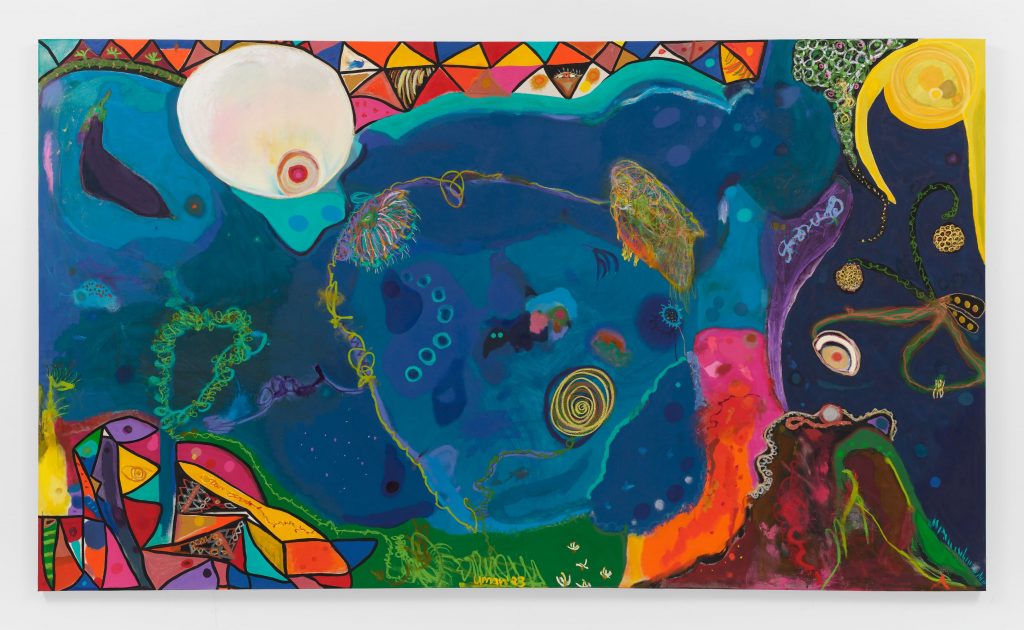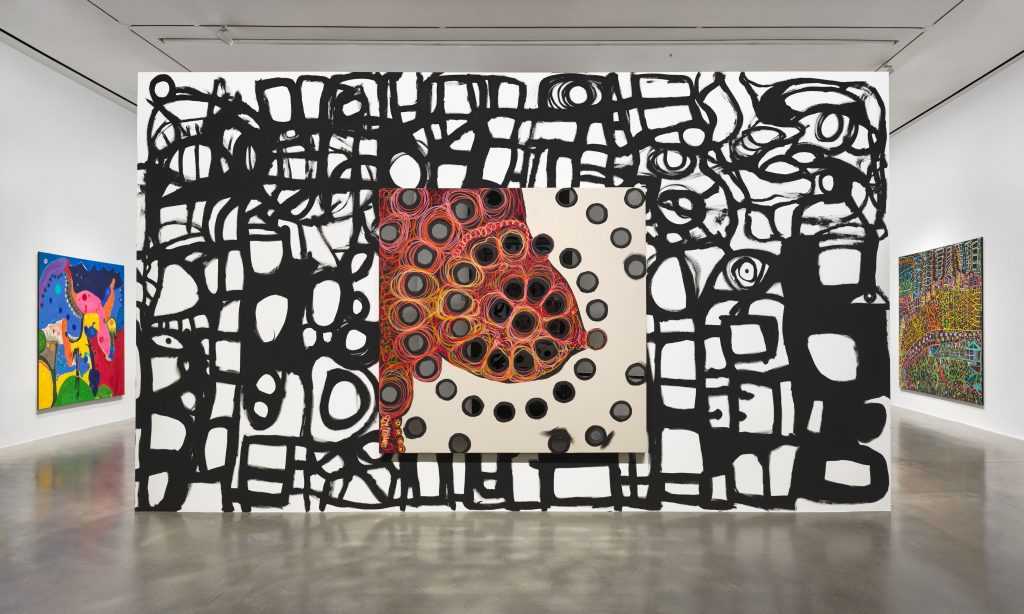Art World
‘I Follow That Gut Feeling’: Uman’s Kaleidoscopic Paintings Emerge From Her Dreams
"Darling Sweetie, Sweetie Darling" is on view at Hauser & Wirth, London, through March 30.

"Darling Sweetie, Sweetie Darling" is on view at Hauser & Wirth, London, through March 30.

Emily Steer

Uman’s paintings are intense, playful, and powerfully consuming. Created in a kaleidoscope of vibrant blues, reds, yellows, purples, and greens, her densely packed shapes and forms jostle with one another on the canvas, almost moving before the viewer’s eyes. Born in Somalia, raised in Kenya, and now based in upstate New York, the painter has a practice of energetic intuition, reflecting both the world outside her studio, and within her own mind. “For me it’s nature, it’s landscape,” she told Artnet, ahead of her first solo show opening at Hauser & Wirth on London’s Savile Row. Her abstract works could also be seen as self-portraits, reflecting deep emotional and dream states.
Uman paints, draws, and has also created collaborative sculptures. “Darling Sweetie, Sweetie Darling” at Hauser & Wirth (until 30 March 2024) brings together a selection of large paintings anchored by a vast, monochrome mural that greets viewers upon entry. A canvas hangs on both walls of this double-sided mural, covered in a spiral of circular mirrors which reflect the viewer’s face and other works in the show from different angles. Each painting can be read on both a micro and macro level, variously suggestive of the delicate internal structures of natural forms or the depths of the ocean. A single portrait hangs on one wall, with an open-mouthed figure emerging from abstract surroundings.
All the works have a frenetic, fluid movement to them, which evokes scenes of the artist in a meditative or performative state in the studio. “I like the idea of just feeling,” she said. “Going into the studio and picking a color, and going with that feeling, that color, that emotion in that moment. The only thing pre-planned is sometimes the silhouettes. Like the geometric elements, or the circle shapes; I consider them ‘orbs’. They could also be seen as buds; they could be the moon.”

Installation view, “Uman: Darling sweetie, sweetie darling” at Hauser & Wirth London. © Uman. Courtesy the artist, Hauser & Wirth and Nicola Vassell Gallery. Photo: Alex Delfanne.
While the works are often instinctively created, she has previous training in Arabic calligraphy, and the precision of this line work is evident in her painting. “When I was growing up, I had to learn Arabic,” she said. “All the kids had to learn how to write on a piece of wood with a stick and ink. I think I took that idea and put it into how my movements are now. I paint right to left. I feel like it’s a dance. It’s physical. But it feels automatic now.”
Her paintings can also be read emotionally. She does not spell out the personal resonance of each piece but leaves this open to the viewer’s interpretation. “It’s a very emotional experience to be a painter,” she said. “I’m not an academic, I’m not a conceptual artist. I follow that gut feeling.” Many of her palettes could lead to a joyful understanding of the paintings, but there is darkness within them too. “There is a lot of sadness,” she said. “I was mourning when I did these paintings. There is melancholia, there is sadness, there is joy. It all depends on the day. They are tumultuous, everything. You can’t have any one emotion. But I do love when people say they see joy.”

Uman, Good Morning (2023). © Uman. Courtesy of the artist, Hauser & Wirth and Nicola Vassell Gallery. Photo: Sarah Muehlbauer.
Uman also explores the depths of subconscious thought. She describes a reciprocal relationship between the paintings and her dreams, whereby the paintings will begin to enter her mind while she sleeps, and the resulting dreams might then feed back into them. This happens especially when she is close to finishing works. There is something both sublime and overwhelming about many of her paintings. She experienced the terrifying altered states of malaria multiple times as a child, which she feels lucky to have recovered from. The potent, visceral experience of these psychological trips has stayed with her. “They’re so crazy,” she said. “It’s almost like you’re on mushrooms, these shapes and colors just hit you. When I had Covid in 2020, and I had a 103-degree fever, and I went back to being this kid with malaria, it was the same feeling.”
Much of her life now is spent in her studio, surrounded by nature. “I like to be alone, but I’m not lonely,” she said. “I have lots of friends and I’m constantly on the phone while I’m working. I have a headpiece all the time, on the phone with certain people three, four, five times a day. It’s a good thing for me; that’s how I’m able to survive those long days in the studio. The moments when I’m in a vibe, and I get a call, it just helps me to get it out of my head. It makes me looser. I move around, I don’t just work on one thing at a time.”
Her studio also features various glass forms made in collaboration with others. Her recurring orbs have been reimagined in blown glass, and a streetlamp from outside has been reinterpreted in her studio, with a large, glowing white bulb. Within her Hauser & Wirth exhibition, the circular mirrors that embellish the first two works are a nod to this round, containing, glass shape. The broader spiral they each form creates a similar sense of containment and is another motif that recurs through Uman’s oeuvre. “I love spirals, just by intuition,” she said. “I’ve always loved them since I was doodling as a child.”

Installation view, “Uman: Darling sweetie, sweetie darling” at Hauser & Wirth London. © Uman. Courtesy the artist, Hauser & Wirth and Nicola Vassell Gallery. Photo: Alex Delfanne.
The artist got into trouble at school for her continuous doodling on desks, which her parents had to pay for. She was always drawing or making in some form, whether instinctively sketching shapes or cutting up and sewing clothes together. It wasn’t until she moved to New York that painting came to the fore. “In 2006 or 2007, I became very serious and started to actually do work,” she said. “I didn’t have my first show until I was 35, at White Columns. There were times when I didn’t have the finances to buy the supplies I wanted to, but I used what I could. This is something I have to do; it keeps me going.”
While her star continues to rise within the art world, Uman stays rooted to the process of making, spending as much time in the studio as possible. “I feel like I was born to be creative, but I didn’t have any idea where it would take me,” she said. “It was magical coming to New York and discovering this is what I wanted to do. I believe in dedicating yourself to one thing and doing it until the wheels fall off.”